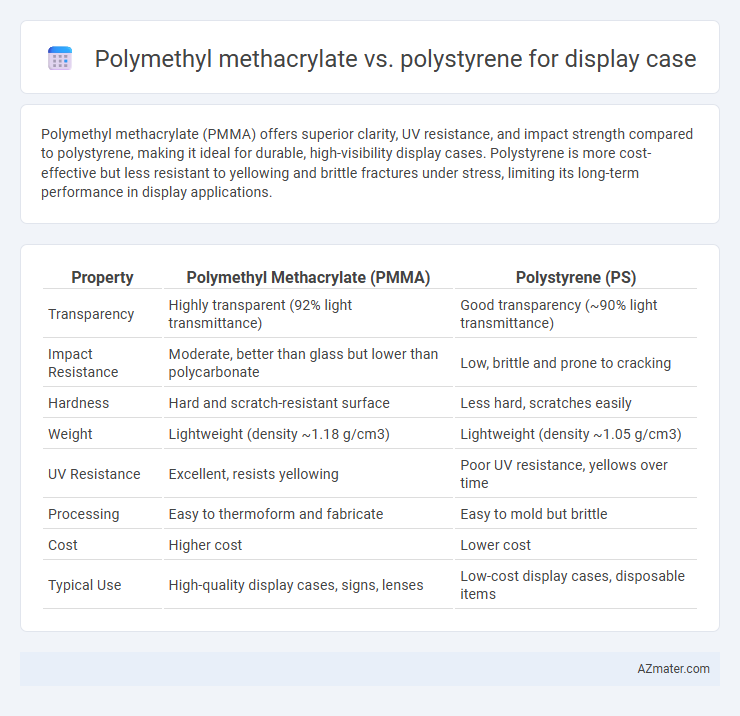Polymethyl methacrylate (PMMA) offers superior clarity, UV resistance, and impact strength compared to polystyrene, making it ideal for durable, high-visibility display cases. Polystyrene is more cost-effective but less resistant to yellowing and brittle fractures under stress, limiting its long-term performance in display applications.
Table of Comparison
| Property | Polymethyl Methacrylate (PMMA) | Polystyrene (PS) |
|---|---|---|
| Transparency | Highly transparent (92% light transmittance) | Good transparency (~90% light transmittance) |
| Impact Resistance | Moderate, better than glass but lower than polycarbonate | Low, brittle and prone to cracking |
| Hardness | Hard and scratch-resistant surface | Less hard, scratches easily |
| Weight | Lightweight (density ~1.18 g/cm3) | Lightweight (density ~1.05 g/cm3) |
| UV Resistance | Excellent, resists yellowing | Poor UV resistance, yellows over time |
| Processing | Easy to thermoform and fabricate | Easy to mold but brittle |
| Cost | Higher cost | Lower cost |
| Typical Use | High-quality display cases, signs, lenses | Low-cost display cases, disposable items |
Introduction to Display Case Materials
Polymethyl methacrylate (PMMA) and polystyrene are widely used materials for display cases due to their clarity and durability. PMMA offers superior optical transparency, UV resistance, and impact strength, making it ideal for premium display cases that require long-term visibility and protection. Polystyrene provides a more cost-effective solution with reasonable clarity and rigidity but lacks the UV resistance and impact durability of PMMA, limiting its use to short-term or budget displays.
Overview of Polymethyl Methacrylate (PMMA)
Polymethyl methacrylate (PMMA) is a transparent thermoplastic often used as an alternative to glass in display cases due to its superior clarity and impact resistance. PMMA offers excellent weatherability and UV resistance, making it ideal for both indoor and outdoor displays. Its lightweight nature and ease of fabrication allow for versatile design options compared to polystyrene, which is more brittle and less durable in long-term applications.
Overview of Polystyrene
Polystyrene is a lightweight, rigid thermoplastic commonly used for display cases due to its excellent clarity and ease of fabrication. It offers good impact resistance and cost-effectiveness but is more brittle compared to polymethyl methacrylate (PMMA). Polystyrene's lower UV resistance and susceptibility to scratching limit its durability and long-term outdoor use in display applications.
Visual Clarity: PMMA vs. Polystyrene
Polymethyl methacrylate (PMMA) offers superior visual clarity with higher light transmittance of approximately 92%, compared to polystyrene's average of 88%, resulting in clearer, brighter displays. PMMA's surface hardness also reduces scratches, maintaining its transparency longer under frequent use. Polystyrene, while cost-effective, tends to yellow and degrade more quickly, compromising the display case's aesthetic appearance over time.
Durability and Impact Resistance Comparison
Polymethyl methacrylate (PMMA) offers superior clarity and UV resistance compared to polystyrene, making it ideal for long-lasting display cases exposed to sunlight. PMMA exhibits excellent impact resistance and durability, resisting cracks and discoloration better than polystyrene, which is more prone to brittleness and yellowing over time. For high-traffic or outdoor display cases, PMMA's toughness and weather resistance provide enhanced protection and longevity relative to polystyrene.
Weight and Handling Differences
Polymethyl methacrylate (PMMA) is significantly lighter than polystyrene, making display cases easier to handle and transport. PMMA also offers superior rigidity and impact resistance compared to polystyrene, which is more brittle and prone to cracking under stress. These weight and handling advantages position PMMA as a preferred material for durable, lightweight display cases in retail and exhibition environments.
UV Resistance and Longevity
Polymethyl methacrylate (PMMA) exhibits superior UV resistance compared to polystyrene, making it less prone to yellowing and degradation when exposed to sunlight in display cases. PMMA offers enhanced longevity, maintaining clarity and structural integrity over extended periods, while polystyrene tends to become brittle and discolored over time under UV exposure. These properties make PMMA the preferred material for durable, UV-resistant display cases requiring long-term visual appeal.
Cost Effectiveness and Availability
Polymethyl methacrylate (PMMA) offers higher cost-effectiveness for display cases due to its durability and resistance to UV light, reducing the need for frequent replacements despite a slightly higher initial price compared to polystyrene. Polystyrene is generally more affordable upfront, making it accessible for budget-conscious projects, but it lacks the long-term sturdiness and clarity of PMMA, often resulting in higher replacement costs over time. PMMA's widespread availability through numerous suppliers enhances its practicality for commercial display cases, while polystyrene remains easier to source for short-term, low-cost applications.
Best Use Cases for PMMA and Polystyrene
Polymethyl methacrylate (PMMA) excels in display cases requiring high optical clarity and UV resistance, making it ideal for museums, retail showcases, and outdoor exhibits where transparency and durability are crucial. Polystyrene is best suited for cost-sensitive, short-term display solutions with limited exposure to impact or sunlight, such as promotional displays and temporary signage. PMMA's superior scratch resistance and weatherability outperform polystyrene in long-term, high-visibility applications.
Conclusion: Choosing the Right Material for Your Display Case
Polymethyl methacrylate (PMMA) offers superior optical clarity, UV resistance, and impact strength compared to polystyrene, making it ideal for high-end display cases requiring durability and long-term visibility. Polystyrene is more cost-effective and lightweight but is prone to scratching and yellowing over time, limiting its use to short-term or budget-conscious applications. Selecting the right material depends on prioritizing either premium aesthetics and longevity (PMMA) or affordability and ease of fabrication (polystyrene) for your display case needs.

Infographic: Polymethyl methacrylate vs Polystyrene for Display case
 azmater.com
azmater.com